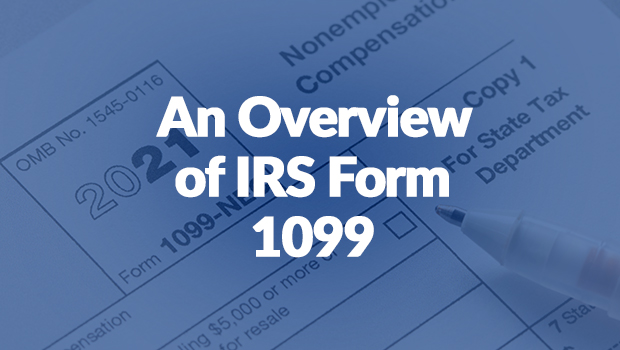There’s a lot of talk about the tax gap and how there are billions of dollars that taxpayers don’t pay (or pay on time) to the IRS. However, a lot of this tax gap doesn’t come from the typical individual.
In fact, because of Form W-2, most taxable income from wages gets reported and paid to the IRS. This is because many employers withhold a portion of their employee’s income each pay period and send it to the IRS automatically.
But what if you’re not a W-2 wage earner? This income may still get reported (although not paid) to the IRS thanks to IRS Form 1099. In this month’s blog post, we’ll provide an overview of this form (as it applies to individual taxpayers), cover when and why it exists and provide some tips on how to make sure you properly report and pay your taxes if you receive one or more 1099 forms.
What Is Form 1099?
IRS Form 1099 is a document that gets filed with the IRS to report various forms of non-employment income (income other than wages, salaries and tips). This means income earned in ways that don’t involve working as an employee. A common source of non-employment income is income earned by independent contractors, like freelancers. In this situation, they’ll typically get a 1099-NEC from the client or customer. But many other kinds of 1099 exist.
What Types of 1099s Are There?
There are about two dozen types of 1099 IRS forms, but besides Form 1099-NEC, some of the most common include:
- 1099-K: reports money received from payment cards (like gift cards) and payment apps or online marketplaces (also known as third-party settlement organizations or TPSOs).
- 1099-DIV: reports divided payments from stocks or mutual funds.
- 1099-INT: reports interest earned on bank accounts.
- 1099-R: reports distributions from certain retirement accounts and insurance contracts.
- 1099-G: reports certain government payments, like state or local tax refunds, unemployment compensation and agricultural payments.
- 1099-SA: reports distributions from health savings accounts, Archer Medical Savings Accounts and Medicare Advantage Medical Savings Accounts.
- 1099-S: reports the sale or exchange of real estate
- 1099-MISC: this is for payments that don’t apply to other 1099 forms. Examples include crop insurance proceeds, rents, royalties, prizes, awards and fishing boat proceeds.
Remember, this is not an exhaustive list of all 1099s or situations where they could be generated. Yet this should provide a good idea of when and where a 1099 might exist.
Why Do 1099s Exist?
They exist to make it easier for the IRS to know when someone earns potentially taxable income. Specifically, Form 1099 is a type of information return that the IRS uses to help confirm if and when a taxpayer reports and pays all their taxable income. When the IRS receives a 1099 form for a specific taxpayer, they’ll compare the amount on that form with Form 1040 the taxpayer files a few months later.
If they match, the IRS is happy. If they don’t match because the taxpayer didn’t report income on the 1099, the IRS may send a letter to the taxpayer. This letter will ask the taxpayer to pay the unpaid tax bill or explain why the taxpayer shouldn’t have to pay taxes on the income reported on the 1099.
When Do Form 1099s Get Generated?
An entity is required to create a 1099 form and send it to the taxpayer and the IRS only under certain conditions. This is typically when the taxpayer receives a certain amount of money.
For example, under current IRS rules, a 1099-K gets generated if more than $600 in payments were received using a TPSO. However, the IRS is currently in the process of raising this threshold to $5,000 for 2024.
With 1099-NEC, a business must create this form if they pay at least $600 to someone for services and that individual is not an employee. Then there are forms 1099-INT and 1099-DIV, which typically get sent to taxpayers if they receive $10 or more in interest or dividends.
How to Avoid Tax Problems with Form 1099
Most 1099s gets sent out by late January. If you don’t receive one you’re expecting by early February, you should contact the entity that should have sent you the 1099. If they still don’t send you one, you can contact the IRS or talk to your tax preparation professional to decide what to do next.
Keep in mind that the 1099 doesn’t officially declare what you owe in taxes. So the income on a 1099 might not be subject to tax because there’s an income tax exclusion that applies. Conversely, even though a 1099 wouldn’t get generated for the $500 you receive from a single job as a freelancer, you could still owe taxes on the $500.
When you receive your 1099, make sure it’s accurate. The last thing you want is for some company to tell the IRS you have $5,000 in taxable income when you only earned $1,000.
Conclusion
For most taxpayers, 1099 forms usually don’t cause any problems or issues. But in the rare instances when they do, it may require the help of a tax professional. They can figure out what to do next and correct any errors or misunderstandings between you and the IRS.
Kienitz Tax Law is here to help you with your tax issues. Schedule your FREE consultation today!

